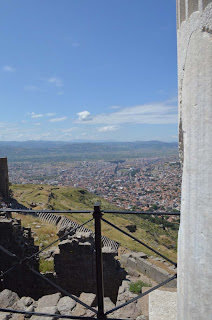Pergamum is the third church mentioned in the book of Revelation.
Revelation 2:12-17 reads:
‘These things says He who has the sharp two-edged sword (Jesus Christ):
“I know your works, and where you dwell, where Satan’s throne is. ... “He who has an ear, let him hear what the Spirit says to the churches. To him who overcomes I will give some of the hidden manna to eat. And I will give him a white stone, and on the stone a new name written which no one knows except him who receives it.”’
I'm not going to give a full Bible Study here, but remember the points
underlined, as they will be referred to further down.
We left bright and early in the morning...
 |
| Some of the roads in Turkey... :) |
|
|
|
...and made our way to the church placed at one of the highest altitudes...
 |
| The edges of Pergamum from a distance |
|
 |
| We needed to go up by lift |
|
 |
| The path by foot is treacherously unavailable |
|
 |
| A shot on the way up |
|
 |
| The lay of the land... |
|
 |
| "Bergama" is Turkish for "Pergamum" |
|
|
|
|
|
See, Pergamum was abandoned because it was so high up. It was a good, defensible place, but, the problem was bringing up water to this altitude.
|
 |
| This massive tree is the spot where the great altar of Zeus once stood. |
Lesson on the Altar of Zeus
Did you know? When the Bible refers to Pergamum, it refers to the city as the "seat of Satan's throne". Scholars believe that this was fittingly attributed to the altar of Zeus. Others say that it referred to the 22 pagan temples in the city.
The Altar to Zeus was built after a victory over the Gauls. It is told that before the battle, the people asked for a sign from Zeus on whether they would win. In response, apparently a symbol of "Nike" (yes, the one that the shoes are branded with) appeared on the liver of an animal that they had cut open. They thought it was a sign of Zeus' favor and decided to build this altar.
After the 4th century AD, Christianity increased, and many of the Greek gods lost their importance. As the people started to leave the city and move down, the locals began to use the marble in the city to build their homes.
In the 19th century, the Germans were looking for marble. The locals told them to go to the top of the hill, and there, they found the Temple of Zeus. The Germans dismantled it and brought it with them to Germany, and it's actually there now in the Museum of Pergamum :)
|
 |
| Going by the altar, we followed the path into the auditorium |
|
 |
| The view from the path... |
|
 |
| The steepest auditorium ever! |
|
 |
| We had our Sabbath service here |
|
 |
| If you see the pole in the bottom-right, that's the base. From there you can hear people speaking all the way to the top |
|
 |
| After we sang for Sabbath, kids came and sang to us in Turkish. |
|
 |
| Pergamum is a *huge* city |
|
|
 |
| These are pillar sockets, and this is how they stacked them on top of one another... |
|
|
|
 |
| One of the things that Pergamum is really famous for is "white stone" (a.k.a. white marble) |
|
 |
| Roman Emperor Trajan expanded a lot of Pergamum |
Short History Lesson on Pergamum
Pergamum was founded in the 3rd century BC (the Hellenistic Age) by Lysimachus. The name "Pergamos" means "castle of strength
|
|
|
|
|
|
 |
| These are the ruins of the Temple of Trajan (the Emperor) |
|
|
|
|
|
|
|
|
|
|
 |
| The Plan of the Theater at Pergamum |
|
|
|
 |
| The base of the Theater |
|
|
|
 |
| The Altar of Zeus from another angle |
Short Lesson on the Development of Parchment
Pergamum was actually famous for quite a number of things, but unfortunately, what was see here is pretty much all that exists today. Once upon a time it was the location of the second largest library in the ancient world, containing about 200,000 volumes. (Alexandria was the first and Ephesus was the third).
In order to prevent Pergamum from being more famous than Alexandria, the Alexandrians stopped exporting papyrus to Pergamum. So, Pergamum invented parchment instead, and they called it "Pergamino"
Next Stop: The fabled city of Troy |





















































No comments:
Post a Comment